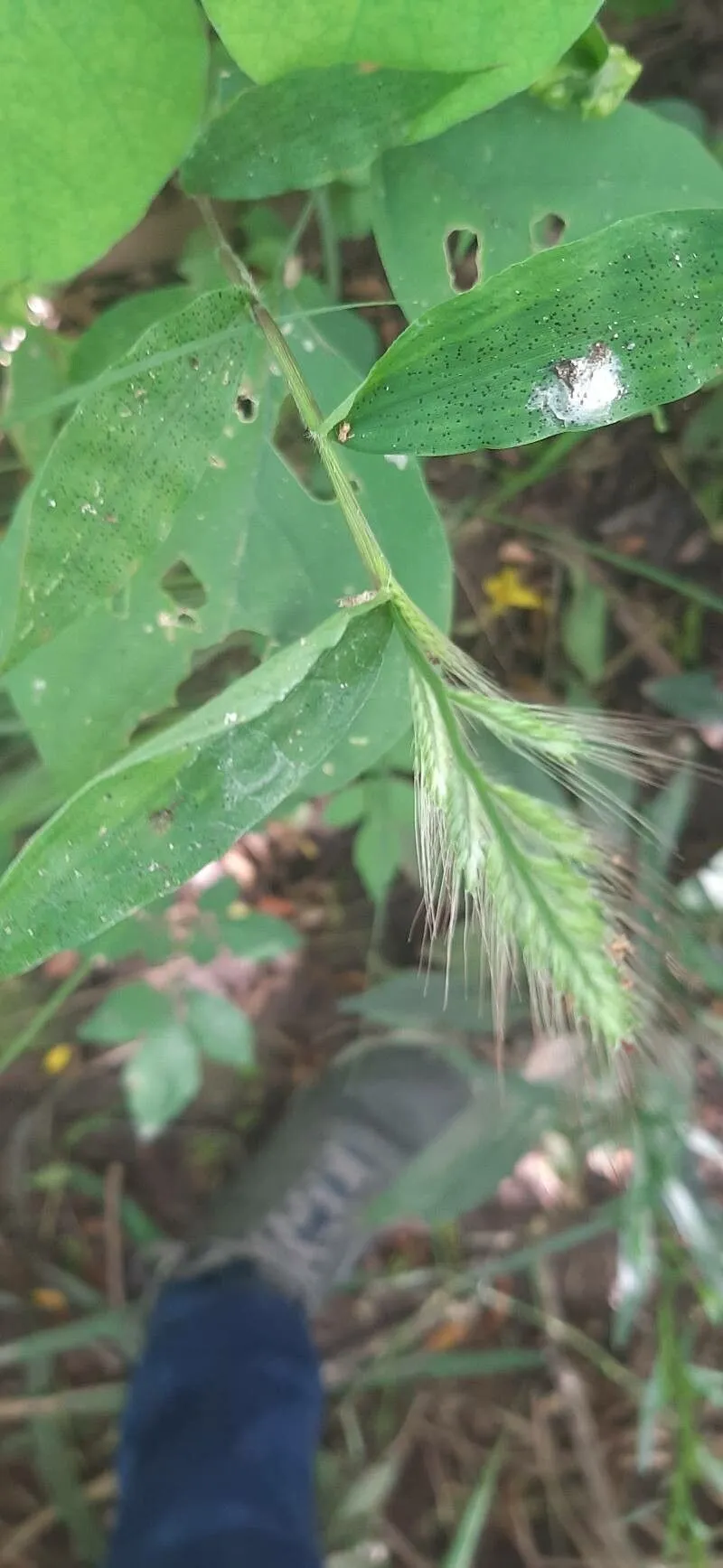

Family: Poaceae
Author: (Retz.) P.Beauv.
Bibliography: Ess. Agrostogr.: 54 (1812)
Year: 1812
Status: accepted
Rank: species
Genus: Oplismenus
Vegetable: False
Observations: Trop. & Subtrop. Old World
Description
Burmann’s basketgrass, scientifically known as Oplismenus burmanni, is an intriguing species of grass belonging to the Poaceae family. Described extensively in the literature, with a notable bibliographic entry in Ess. Agrostogr.: 54 (1812), this species carries a rich history of botanical interest, attributed reasonably to its discoverer, (Retz.) P. Beauv.
Found predominantly in the tropical and subtropical regions of the Old World, Burmann’s basketgrass thrives in a variety of climates where warmth and humidity prevail. This adaptability makes it a remarkable specimen among its grassy peers. The spread of Oplismenus burmanni covers vast stretches, showcasing its resilience and ability to flourish in diverse environmental conditions.
As a member of the Poaceae family, which encompasses a significant portion of the world’s grass species, Burmann’s basketgrass shares many of the characteristics that define grasses, like slender leaves and a fibrous root system. However, it stands out due to its unique growth patterns and the intricate basket-like formations its foliage often creates, lending it both its common name and its botanical significance.
Its utility can extend beyond mere aesthetic value, contributing to ecological stability by preventing soil erosion, providing cover for small wildlife, and adding biodiversity to the regions it inhabits. Though not as commonly discussed as some other members of the Poaceae family, Oplismenus burmanni remains a fascinating subject for botanists and ecologists alike, who are drawn to its unique presence in both natural habitats and research discussions.
Common Names
Eng: burmann’s basketgrass
En: Burmann’s basketgrass
Synonyms
- Panicum cristatum ((J.Presl) Steud.)
- Panicum francoi (Steud.)
- Oplismenus burmanni var. albidulus (N.E.Br.)
- Oplismenus burmanni var. lanatus ((Buse) Backer)
- Orthopogon burmanni ((Retz.) R.Br.)
- Oplismenus undulatifolius var. japonicus ((Steud.) Koidz.)
- Panicum ischnocaulon (Steud.)
- Oplismenus baronii (A.Camus)
- Panicum bromoides (Lam.)
- Oplismenus burmanni var. nudicaulis ((Vasey) McVaugh)
- Hippagrostis burmanni ((Retz.) Kuntze)
- Oplismenus gracillimus (Mez)
- Panicum album (Poir.)
- Orthopogon bromoides ((Lam.) G.Don)
- Orthopogon burmanni var. glabrescens (Buse)
- Oplismenus cristatus (J.Presl)
- Oplismenus gracilis (Schltdl.)
- Oplismenus japonicus ((Steud.) Honda)
- Oplismenus albus ((Poir.) Roem. & Schult.)
- Oplismenus multisetus (A.Rich.)
- Oplismenus affinis var. humboldtianus (U.Scholz)
- Oplismenus mollissimus (Hochst. ex Steud.)
- Oplismenus humbertianus (A.Camus)
- Oplismenus humboldtianus (Nees)
- Panicum multisetum ((A.Rich.) Steud.)
- Panicum lappaceum (Willd. ex Spreng.)
- Panicum schultesii (Steud.)
- Orthopogon burmanni var. lanatus (Buse)
- Oplismenus preslii (Kunth)
- Oplismenus affinis (Schult.)
- Oplismenus burmanni f. cristatus ((J.Presl) Hiern ex Peter)
- Oplismenus burmanni var. multisetus ((A.Rich.) U.Scholz)
- Orthopogon albus ((Poir.) Nees ex Steud.)
- Oplismenus hirtellus subsp. japonicus ((Steud.) U.Scholz)
- Oplismenus hookeri (Parl.)
- Panicum sanctae-marthae (Steud.)
- Oplismenus humboldtianus var. nudicaulis (Vasey)
- Oplismenus humboldtianus var. muticus (E.Fourn.)
Distribution
- Andaman Is. (native)
- Assam (native)
- Bangladesh (native)
- Benin (native)
- Botswana (native)
- Burkina (native)
- Burundi (native)
- Cameroon (native)
- Cape Verde (native)
- Central African Repu (native)
- China North-Central (native)
- China South-Central (native)
- China Southeast (native)
- Comoros (native)
- Congo (native)
- East Himalaya (native)
- Ethiopia (native)
- Gabon (native)
- Gambia (native)
- Ghana (native)
- Guinea (native)
- Guinea-Bissau (native)
- Gulf of Guinea Is. (native)
- India (native)
- Ivory Coast (native)
- Jawa (native)
- Kenya (native)
- Korea (native)
- Laccadive Is. (native)
- Lesser Sunda Is. (native)
- Liberia (native)
- Madagascar (native)
- Malawi (native)
- Malaya (native)
- Maluku (native)
- Mauritius (native)
- Mozambique (native)
- Myanmar (native)
- Namibia (native)
- Nepal (native)
- New Guinea (native)
- Nigeria (native)
- Northern Provinces (native)
- Northern Territory (native)
- Oman (native)
- Pakistan (native)
- Philippines (native)
- Queensland (native)
- Réunion (native)
- Senegal (native)
- Sierra Leone (native)
- Socotra (native)
- Solomon Is. (native)
- Sri Lanka (native)
- Sudan (native)
- Sulawesi (native)
- Sumatera (native)
- Tanzania (native)
- Thailand (native)
- Togo (native)
- Tonga (native)
- Transcaucasus (native)
- Vietnam (native)
- West Himalaya (native)
- Zambia (native)
- Zaïre (native)
- Zimbabwe (native)
- Belize (introduced)
- Bolivia (introduced)
- Brazil Northeast (introduced)
- Colombia (introduced)
- Costa Rica (introduced)
- Cuba (introduced)
- Dominican Republic (introduced)
- Ecuador (introduced)
- El Salvador (introduced)
- Florida (introduced)
- Galápagos (introduced)
- Guatemala (introduced)
- Haiti (introduced)
- Hawaii (introduced)
- Honduras (introduced)
- Mexico Central (introduced)
- Mexico Gulf (introduced)
- Mexico Northeast (introduced)
- Mexico Northwest (introduced)
- Mexico Southeast (introduced)
- Mexico Southwest (introduced)
- Nicaragua (introduced)
- Panamá (introduced)
- Peru (introduced)
- Venezuela (introduced)
- Windward Is. (introduced)
Additional Images
Flower


Taken Oct 27, 2022 by Cabezas Enmanuel (cc-by-sa)


© copyright of the Board of Trustees of the Royal Botanic Gardens, Kew.


© copyright of the Board of Trustees of the Royal Botanic Gardens, Kew.


© copyright of the Board of Trustees of the Royal Botanic Gardens, Kew.
Sources
- WFO (No URL)
- IPNI (No URL)
- GBIF (https://www.gbif.org/species/2705738)
- POWO (http://powo.science.kew.org/taxon/urn:lsid:ipni.org:names:30453766-2)
- PlantNet (https://identify.plantnet.org/species/the-plant-list/Oplismenus burmanni (Retz.) P.Beauv.)
Specifications
Growth
